Cutting-Edge Military Flight Technology: From Analog Systems to 5th Generation Fighters.
Advancements in Cutting Edge Military Flight Technology have redefined modern air combat, encompassing everything from aerodynamic breakthroughs to the integration of advanced avionics and weaponry.
This evolution has transitioned from rudimentary analog systems to highly sophisticated digital architectures that underpin the 5th generation fighter aircraft. Let’s explore the remarkable innovations shaping the future of aerial dominance.
Fuselage and Wing Design: Precision Meets Efficiency
The aerodynamic design of modern military aircraft emphasizes stealth, agility, and efficiency. Unlike the sharp, angular fuselages of early jets, contemporary fighters utilize smoother, radar-absorbent materials and surfaces that minimize their radar cross-section (RCS).
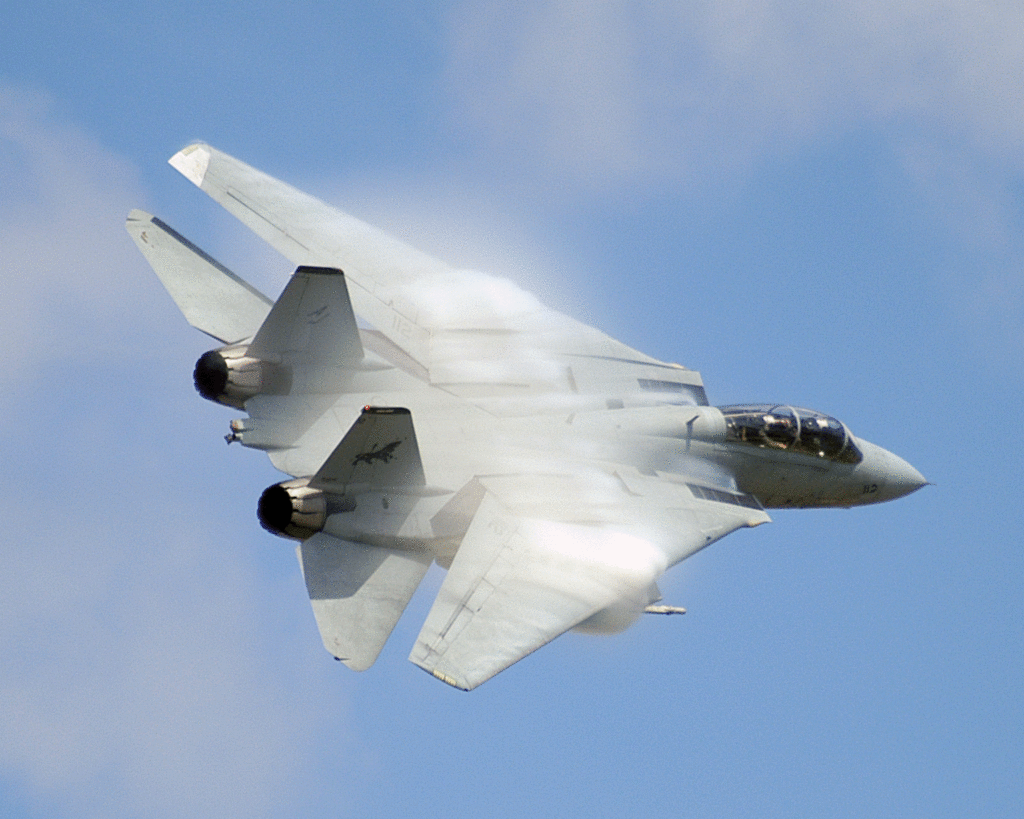
Cutting Edge Military Flight Technology – Stealth and Supermaneuverability
- Stealth technology: The F-22 Raptor and F-35 Lightning II feature faceted designs, coatings, and internal weapon bays to reduce RCS and infrared signatures. These innovations allow them to penetrate contested airspace undetected.
- Canards and forward-swept wings: Aircraft like the Eurofighter Typhoon utilize canard fore planes for increased manoeuvrability and stability, ensuring optimal performance in dogfights.
Computational Fluid Dynamics (CFD)
Advancements in CFD have enabled engineers to design aircraft with unparalleled aerodynamic precision. For example, the F-35’s blended wing-body design reduces drag while accommodating internal weapons bays to enhance stealth.
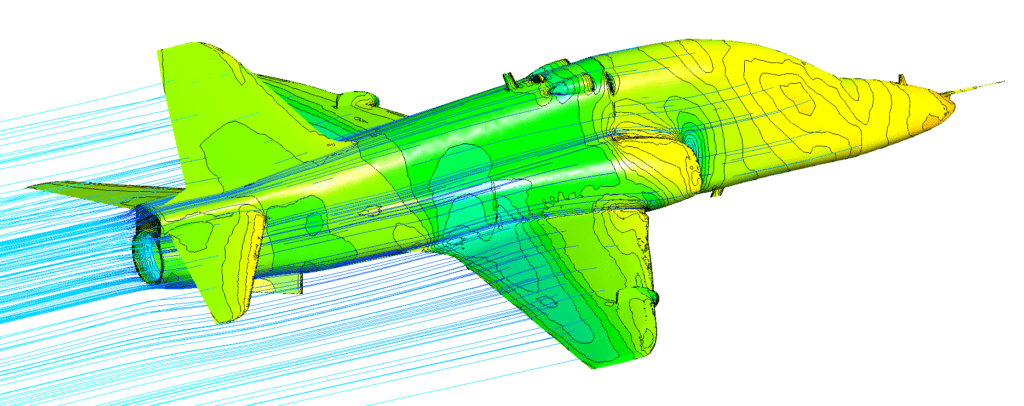
Computational Fluid Dynamics (CFD) is a branch of fluid mechanics that uses numerical methods and algorithms to solve and analyse problems involving fluid flows. It involves using computer simulations to model the behaviour of gases or liquids, particularly how they interact with surfaces, structures, or other materials.
CFD software divides the flow domain into small cells and uses mathematical equations (like the Navier-Stokes equations) to calculate fluid properties such as velocity, pressure, temperature, and density across these cells. The results are then visualized and analysed to understand flow behaviour, optimize designs, or predict performance.
CFD vs. Traditional Wind Tunnels: CFD offers several advantages over traditional wind tunnels:
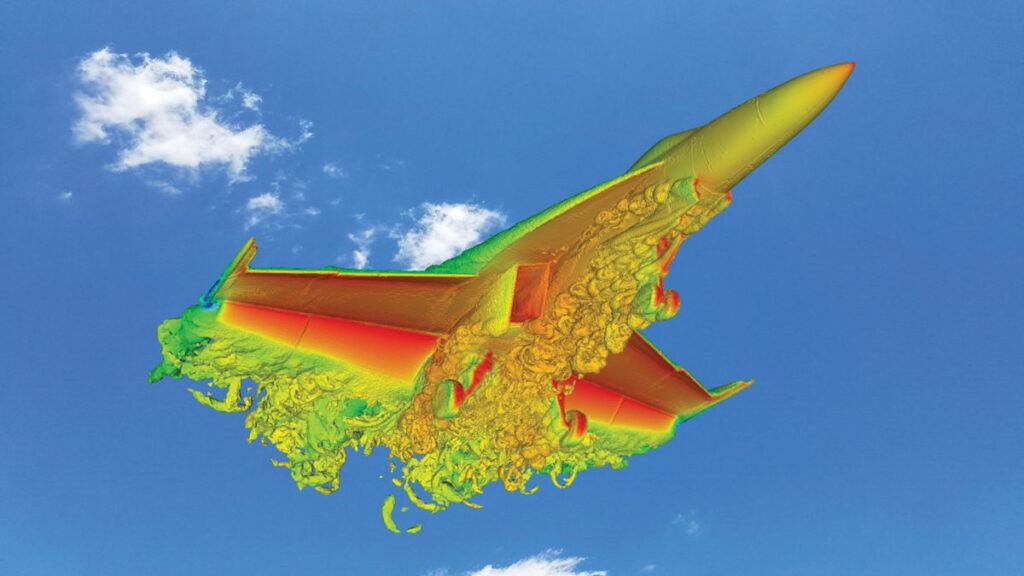
- Cost and Time Efficiency: CFD simulations can be run on a computer without the need for physical models or extensive testing, making it faster and less expensive compared to constructing full-scale wind tunnel facilities.
- Design Flexibility: CFD allows engineers to explore a wide range of design variations quickly and iteratively, which would be far more difficult and expensive in a wind tunnel.
- Complexity and Detail: CFD can model complex geometries and fluid behaviours (like turbulence or multi-phase flows) in ways that wind tunnels might not be able to due to limitations in physical scaling or measurement capabilities.
However, wind tunnels still have their place, particularly when it comes to validating CFD models or capturing the effects of real-world conditions (e.g., scale effects, material properties, or turbulent interactions). While CFD provides greater flexibility and scope for innovation, wind tunnels remain valuable for experimental validation and fine-tuning.
In summary, CFD is not necessarily “better” than wind tunnels, but it offers unique advantages in terms of cost, flexibility, and precision in simulating complex flows. The best approach often involves using both in tandem: CFD for early-stage design and wind tunnels for validation and final testing.
Powerplant Innovations: The Heart of Modern Fighters
Cutting Edge Military Flight Technologies introduced into military aircraft engines have undergone radical transformations to deliver greater thrust, efficiency, and durability while minimizing their heat signature for stealth operations.
This now includes ADAPTIVE CYCLING ENGINES being added to the F-35 Lightning II in the future which will enables the engine to go into an Economy mode during flight saving about 25% or more fuel but then in the TURBO mode increase thrust considerably.
This technology is revolutionising military and possibly general aviation as the technology is improved but is still reported to be in the development stages.
Thrust Vectoring
Thrust vectoring nozzles, like those on the F-22, provide superior agility by redirecting engine thrust to aid in tight turns, rapid climbs, or evasive manoeuvres. This gives 5th-generation fighters an edge in close-range dogfights.
Thrust vectoring is a technology used in aircraft and spacecraft propulsion systems that allows the direction of the engine’s thrust to be controlled, thereby enabling enhanced manoeuvrability.

In 2D thrust vectoring, the nozzle can move in one plane, typically vertically or horizontally, to adjust the direction of thrust, which improves pitch, yaw, or roll control.
3D thrust vectoring, on the other hand, offers even greater flexibility by allowing the nozzle to move in multiple directions both horizontally and vertically providing full control over all three axes of flight (pitch, yaw, and roll).
This capability enhances the aircraft’s agility, allowing for highly dynamic manoeuvres, particularly in advanced fighter jets and spacecraft.
Cutting Edge Military Flight Technology – Advanced Propulsion Systems
Next generation engines, such as the Adaptive Engine Transition Program (AETP) from GE, promise increased fuel efficiency and customizable performance. These engines can shift between high-thrust and fuel-saving modes, a vital capability for extended missions.
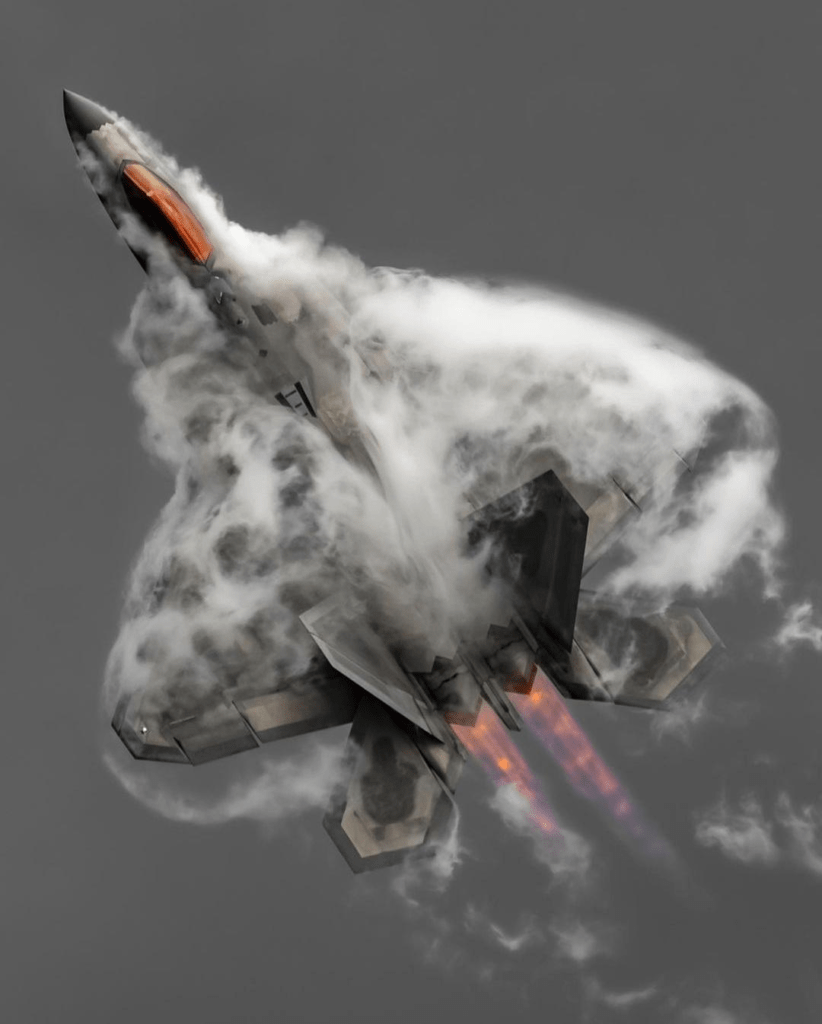
Fly-by-Wire Systems: Replacing Analog with Digital Precision
In the early days of aviation, pilots relied on mechanical linkages and analog controls to manoeuvre aircraft. Modern fighters employ fly-by-wire (FBW) technology, which uses computer systems to interpret pilot inputs and adjust control surfaces with precision.
Advantages of Fly-by-Wire
- Stability augmentation: FBW allows inherently unstable designs, like the F-16 Fighting Falcon, to remain controllable, enhancing manoeuvrability.
- Reduced pilot workload: Digital systems minimize the physical effort required to control the aircraft, allowing pilots to focus on mission-critical tasks.
- Redundancy and reliability: Multiple backup systems ensure continued operation even if primary systems fail.
Digital Cockpits: From Analog Gauges to Integrated Displays
Modern cockpits are masterpieces of digital engineering, incorporating glass displays and multifunction touchscreens that centralize information, replacing cluttered analog gauges.

Cutting Edge Military Flight Technology – 4th and 5th-Generation Avionics
- Heads-Up Displays (HUDs): Early HUDs projected essential flight information onto the windshield. Today, augmented reality HUDs and Helmet-Mounted Displays (HMDs), such as the F-35’s Distributed Aperture System (DAS), provide 360-degree situational awareness.
- Data fusion: Advanced avionics systems compile inputs from multiple sensors into a single, coherent display, offering pilots unparalleled situational awareness.
- Autonomous capabilities: AI-assisted systems in modern cockpits can suggest tactical maneuvers or automatically engage countermeasures in high-stress situations.
Radar Evolution: From Ground Stations to Active Electronically Scanned Arrays
Radar technology has evolved significantly from ground-based radar stations with rotating antennas to Active Electronically Scanned Arrays (AESA). Early radars relied on mechanical rotation to scan the surrounding area, limiting their ability to detect targets quickly and accurately.
AESA radars, however, use hundreds of tiny, electronically controlled antenna elements that can steer and focus the radar beam electronically, providing instantaneous, high-resolution tracking of multiple targets in various directions simultaneously.

This evolution has greatly improved radar reliability, accuracy, range, and the ability to track low-observable (stealth) targets, making AESA radars a cornerstone of modern airborne, naval, and ground-based radar systems.
Historical Perspective
During WWII, radar systems like Britain’s Chain Home Network enabled early detection of enemy aircraft, providing a strategic advantage. These systems evolved into airborne radar by the 1950s, such as the AN/APQ-120 used in the F-4 Phantom II.
Modern Advances
- Active Electronically Scanned Arrays (AESAs): Unlike traditional radar, AESA systems like those on the F/A-18E/F Super Hornet can track multiple targets simultaneously. AESA radars also reduce detection by enemy systems due to their low probability of intercept (LPI) characteristics.
- Synthetic Aperture Radar (SAR): Used for ground mapping, SAR provides high-resolution imagery, crucial for targeting and reconnaissance missions.
Infrared Search and Track (IRST): Detecting the Undetectable
With the rise of stealth technology, radar is no longer the sole tool for tracking adversaries. Infrared Search and Track (IRST) systems have emerged as critical components in modern military aircraft, enabling pilots to detect targets that might otherwise evade radar detection.
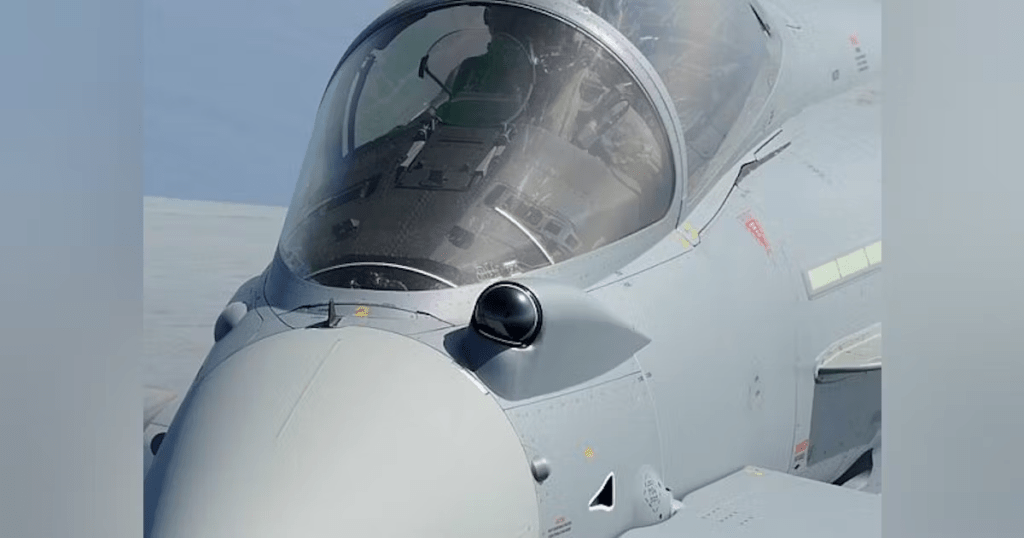
How IRST Works
IRST systems detect the heat signatures of aircraft, missiles, or vehicles, making them especially effective against stealth aircraft designed to evade radar.
Unlike radar, which relies on radio waves that can be jammed or absorbed, IRST systems leverage infrared radiation, which is more difficult to counter.
- Passive Detection: IRST systems are passive, meaning they don’t emit signals that could alert adversaries. This makes them ideal for covert tracking.
- Long-Range Capabilities: Advanced IRST systems, like those in the Su-57 and F-35, can detect targets at long distances, even in environments with high electronic interference.
Cutting Edge Military Flight Technology – Incorporation in Modern Fighters
- Eurofighter Typhoon: Equipped with the PIRATE (Passive Infra-Red Airborne Track Equipment) system, the Typhoon uses IRST for enhanced situational awareness and target acquisition.
- F-35 Lightning II: Integrates IRST within its Distributed Aperture System (DAS), allowing the pilot to track heat-emitting objects across a 360-degree field of view.
Electronically Scanned Array Radar (ESAR): A Quantum Leap in Radar Technology
While early radar systems relied on mechanically moving dishes to detect targets, modern Electronically Scanned Array Radar (ESAR) systems represent a transformative leap forward, offering unmatched precision, speed, and versatility.
What Sets ESAR Apart?
ESAR systems, including Active Electronically Scanned Arrays (AESA), utilize stationary arrays composed of thousands of tiny radar modules. These modules steer the radar beam electronically, rather than mechanically, providing faster and more flexible target tracking.

- Simultaneous Multi-Target Tracking: ESAR can track multiple targets in various directions simultaneously, critical for modern air combat scenarios.
- Low Probability of Intercept (LPI): The radar’s signals are more challenging to detect by enemy systems, maintaining stealth while scanning.
- Weather Resistance: ESAR systems offer better performance in adverse weather conditions compared to older radar technologies.
Impact on Modern Fighters
- F-22 Raptor: Equipped with the AN/APG-77 AESA radar, the Raptor can track airborne threats while maintaining a low radar signature.
- Dassault Rafale: The RBE2 AESA radar enhances detection range, situational awareness, and targeting capabilities in diverse combat scenarios.
- Su-57 Felon: Russia’s advanced fighter employs the N036 Byelka AESA radar, capable of integrating radar and electronic warfare functionalities.
Integrating IRST and ESAR for Network-Centric Warfare
Modern aircraft increasingly combine IRST and ESAR capabilities, enabling them to operate seamlessly in contested airspaces. For example:

- Sensor Fusion: The F-35 fuses data from its AESA radar and IRST systems to provide pilots with a unified picture of the battlespace. This fusion allows for superior target identification and tracking, even against stealthy or electronically shielded adversaries.
- Complementary Strengths: While AESA excels at detecting and tracking targets over long ranges, IRST fills in the gaps by identifying stealthy or radar-jamming threats. Together, they offer unparalleled coverage and redundancy.
By integrating IRST systems and ESAR technology, modern military aircraft ensure dominance in air combat, adapting to evolving threats while exploiting their unique advantages. Let me know if you’d like further refinements or additional points!
Weapon Systems Integration: Beyond Missiles and Guns
Modern military aircraft are platforms for advanced weaponry, combining precision-guided munitions, electronic warfare (EW), and network-centric capabilities.
Beyond Visual Range (BVR) Engagements
- Air-to-air missiles: The AIM-120 AMRAAM (Advanced Medium-Range Air-to-Air Missile) dominates BVR engagements with its ability to lock onto targets well beyond visual range.
- Directed-energy weapons: Research is underway to integrate laser-based systems into next-generation fighters for pinpoint accuracy and unlimited ammunition.
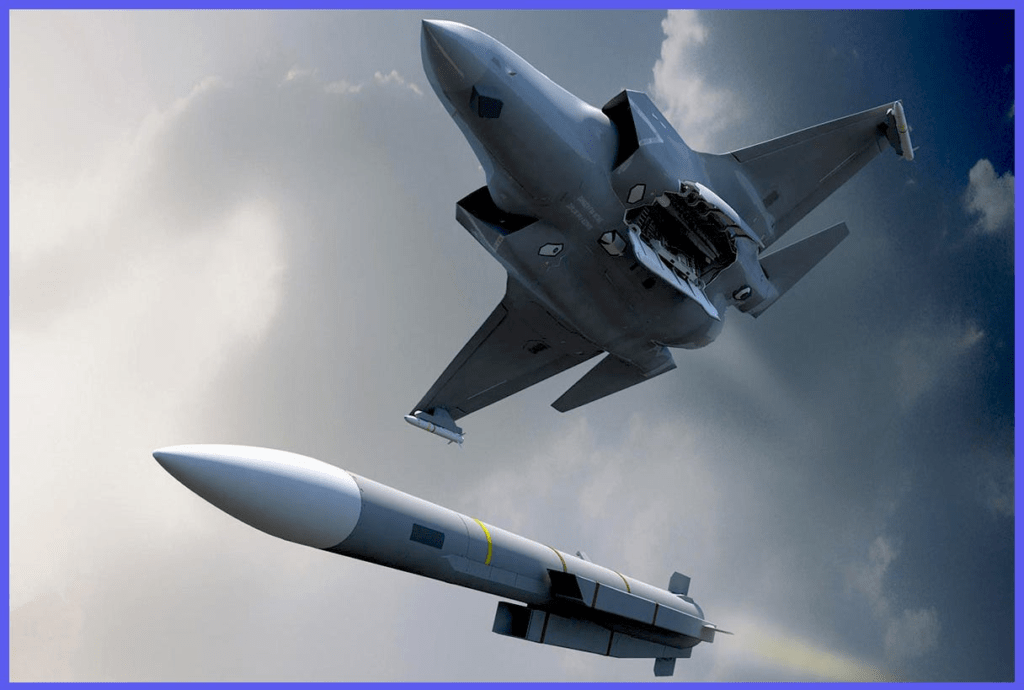
Electronic Warfare
EW pods, such as the AN/ALQ-249 Next Generation Jammer, allow aircraft to disrupt enemy radar and communications while shielding themselves from detection.
Aircraft Interconnectivity: The Rise of Network-Centric Warfare
Modern air combat extends beyond individual aircraft to encompass entire battle networks, where fighters act as nodes in a larger system.
The “Combat Cloud” Concept
- Data sharing: 5th-generation fighters like the F-35 are equipped with advanced data links (e.g., Link 16) to share real-time information with other aircraft, ground forces, and naval units.
- Cooperative engagement: In battle group scenarios, interconnected aircraft can coordinate strikes, prioritize threats, and even use sensors on one platform to guide weapons on another.

Loyal Wingmen and UAVs
Autonomous drones, often referred to as “loyal wingmen,” are being developed to complement manned aircraft. These drones can perform reconnaissance, electronic jamming, or even offensive missions while being directed by human pilots.
Stealth and Counter-Stealth Technologies
While stealth has been a defining feature of modern fighters, adversaries are developing counter-stealth technologies to level the playing field.

Stealth Countermeasures
- Low-frequency radars: These can detect stealth aircraft by exploiting their limitations at longer wavelengths.
- Infrared Search and Track (IRST): Systems like the Eurofighter Typhoon’s PIRATE IRST can detect the heat signatures of stealth aircraft, bypassing radar invisibility.
Future Trends in Military Flight Technology
The relentless pace of innovation ensures that today’s cutting-edge technology will soon be surpassed.
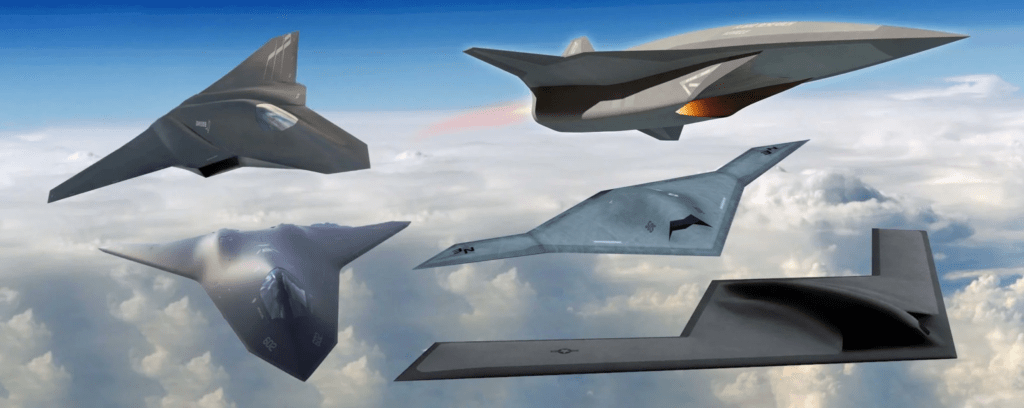
6th-Generation Fighters
- Hypersonic capabilities: Aircraft like the conceptual SR-72 aim to achieve speeds exceeding Mach 5 for strategic reconnaissance and strike missions.
- AI-powered autonomy: Advanced AI could enable autonomous decision-making, reducing pilot workload and improving tactical efficiency.
Cutting Edge Military Flight Technology – Next-Gen Materials
Next-generation materials for stealth and 6th generation aircraft are being developed to enhance aircraft performance while maintaining low observability to radar and other detection systems.
These materials are designed to improve upon traditional stealth coatings and composites by incorporating advanced properties such as better radar-absorption, heat resistance, and electromagnetic interference reduction.
For example, newer metamaterials are being researched to manipulate electromagnetic waves in ways that can make an aircraft virtually invisible to radar.
Additionally, adaptive camouflage materials that can change colour or texture based on the environment could help conceal aircraft in real-time. Innovations in carbon nanotubes and graphene-based composites are also promising, offering lighter, stronger, and more durable structures that can withstand extreme temperatures and stresses while maintaining low radar signatures.
As part of the 6th generation of aircraft, these materials will not only improve stealth but also contribute to better performance, reduced weight, and increased survivability in highly contested airspaces.
Cutting Edge Military Flight Technology – Quantum Radar
Quantum radar is an emerging technology that leverages the principles of quantum mechanics, particularly quantum entanglement, to detect objects with unprecedented precision and sensitivity.
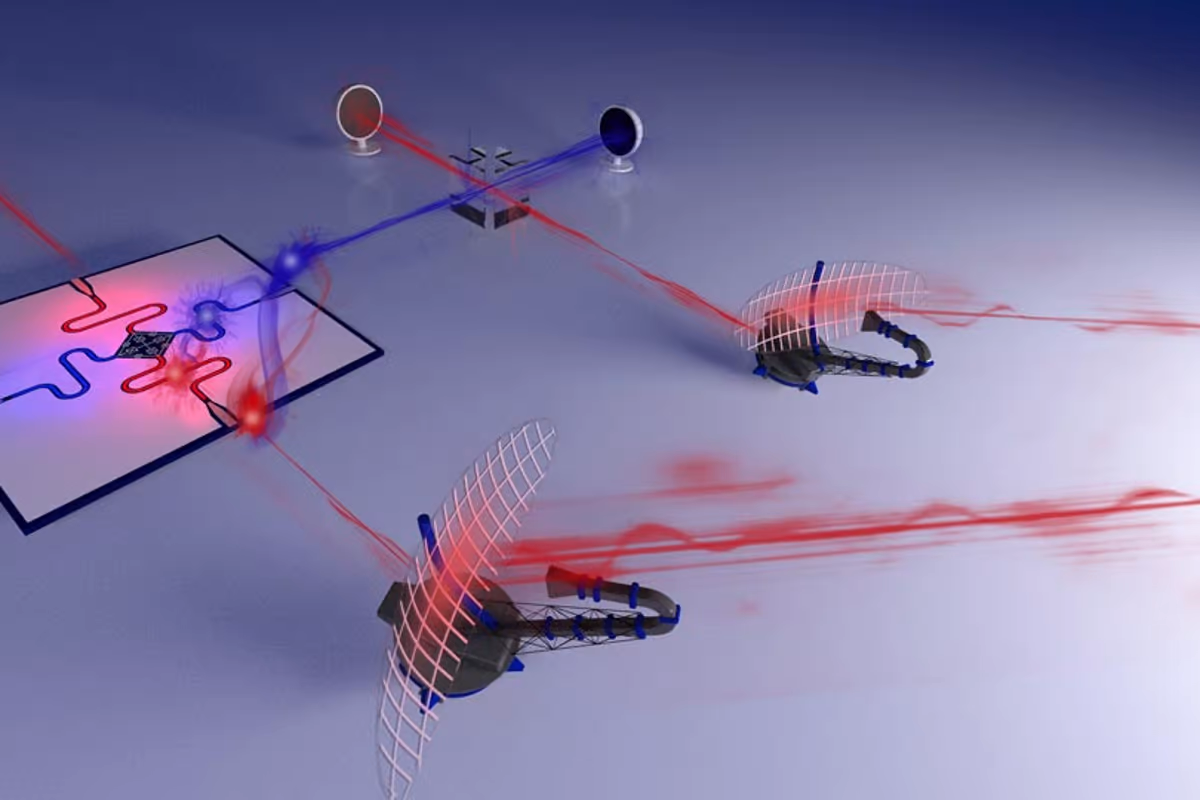
Unlike traditional radar, which relies on classical electromagnetic waves to bounce off objects and return, quantum radar uses entangled photons to detect the slightest disturbances in the quantum state of these particles.
This method allows it to potentially detect objects at much greater distances and with better resolution, while also being more resistant to interference and jamming from stealth technologies.
Although quantum radar is still in the experimental phase and not yet deployed for practical use, significant progress has been made in laboratory settings.
It is likely to be several years, if not decades, before quantum radar becomes a fully realized, operational technology, due to the complex challenges in harnessing quantum properties reliably in real-world applications.
Nonetheless, its potential to revolutionize detection and tracking systems makes it a promising technology for future defence and surveillance systems.
FAQ.
Q1: What makes 5th-generation fighters different from earlier jets?
5th-generation fighters combine stealth, advanced avionics, thrust vectoring, and sensor fusion to dominate modern air combat.
Q2: How does CFD improve aircraft design?
Computational Fluid Dynamics allows engineers to simulate airflow digitally, reducing reliance on wind tunnels and enabling stealthier, more efficient designs.
Q3: What is the role of adaptive cycle engines?
Adaptive engines can switch between fuel-efficient and high-thrust modes, extending range and improving combat performance.
Q4: Why is AESA radar superior to traditional radar?
AESA radars use electronically steered beams, tracking multiple targets instantly while staying harder to detect.
Q5: What future technologies may define 6th-generation fighters?
6th-generation aircraft are expected to feature AI autonomy, hypersonic flight, next-gen stealth materials, and quantum radar.
Conclusion: The Future of Aerial Warfare
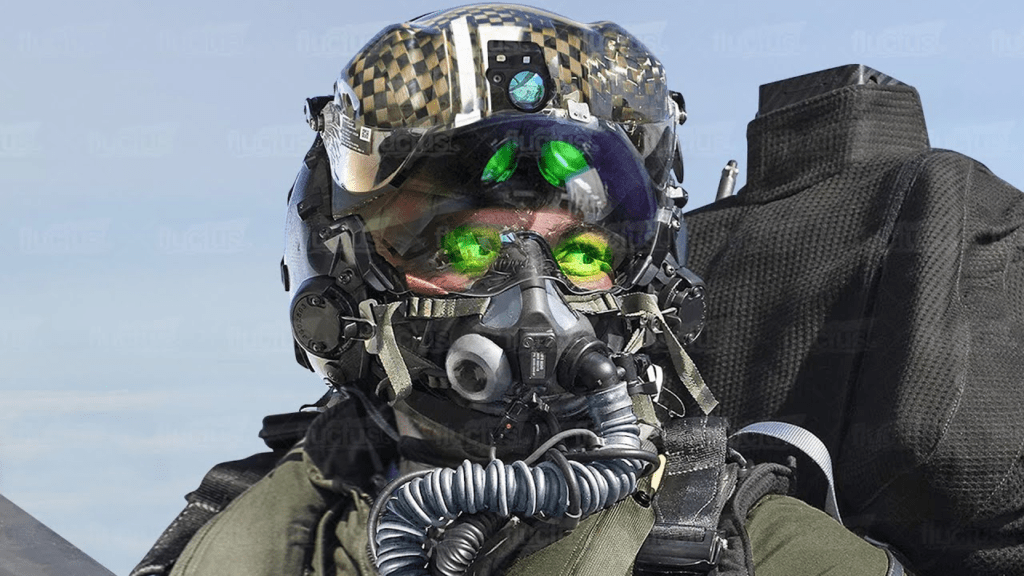
From the rudimentary aircraft of WWII to the sophisticated platforms of today, military flight technology has seen leaps in every domain.
These advancements, from fuselage design and engine propulsion to radar systems and interconnectivity, ensure aerial superiority in increasingly contested airspaces.
As 6th-generation fighters loom on the horizon, the next chapter of aviation innovation promises to be even more revolutionary, solidifying airpower as a critical pillar of military strategy.
By mastering these technological marvels, nations continue to shape the future of warfare, ensuring their air forces remain at the forefront of global defence.
Author

Brendon McAliece (Aka Gunnie) is a military veteran with 23 years working on Jet Fighters, their weapons systems and ejection seat/module systems as well as munitions and R&D. Involved with flight simulation since the 1980s, he has flown all the major flight simulators over the years.
He is an Australian expat who has lived in Malaysia, UK, Saudi Arabia and more recently Thailand. He is a multilingual blogger who loves to share his life experiences here on LetsFlyVFR.com and DreamingGuitar.com, with his lifestyle and Travel experiences Blog plus his Dreaming Coffee website.
Learn More @
DreamingGuitar.com – DreamingCoffee.com – LetsFlyVFR.com
( HOME – BLOG – SHOP – ABOUT )
As an Amazon affiliate I may benefit from qualifying sales.
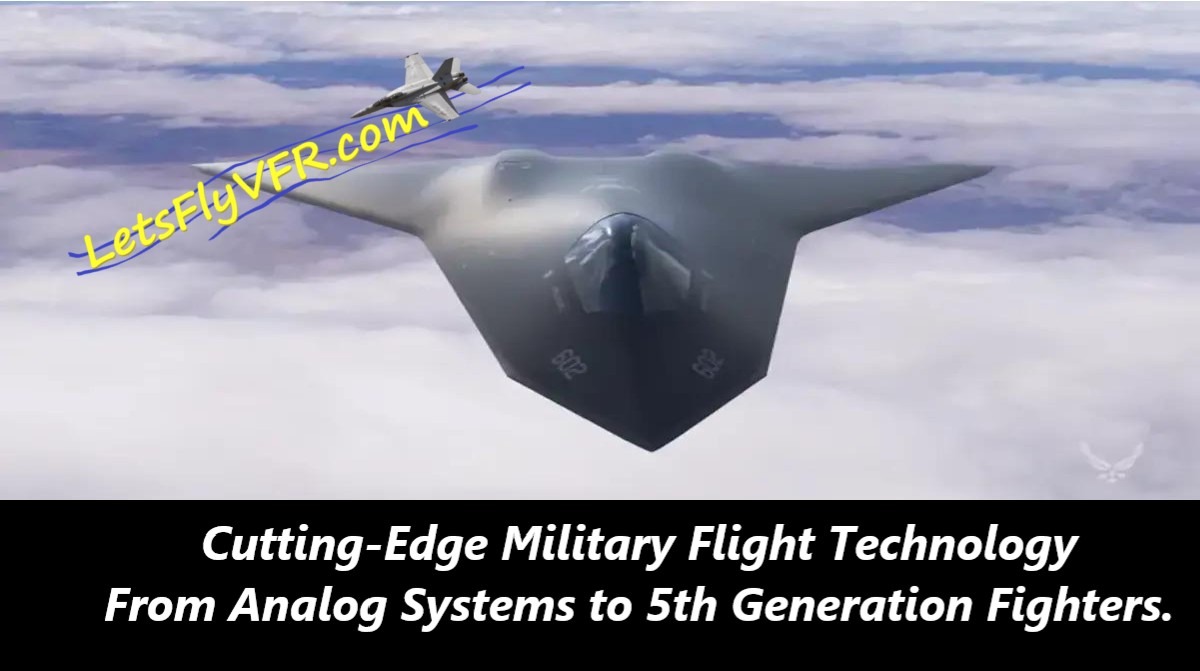



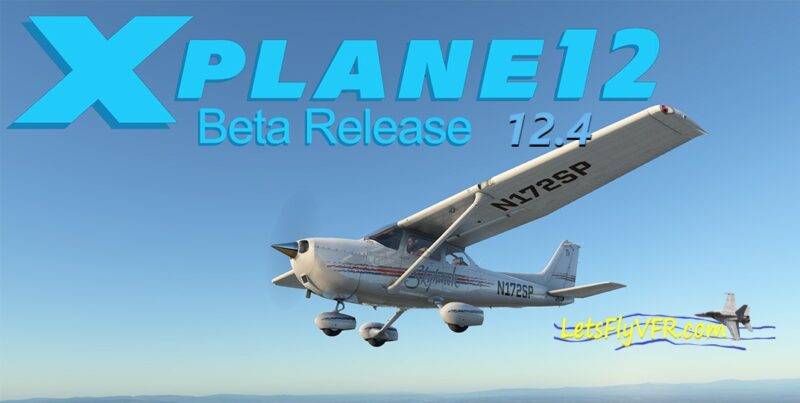
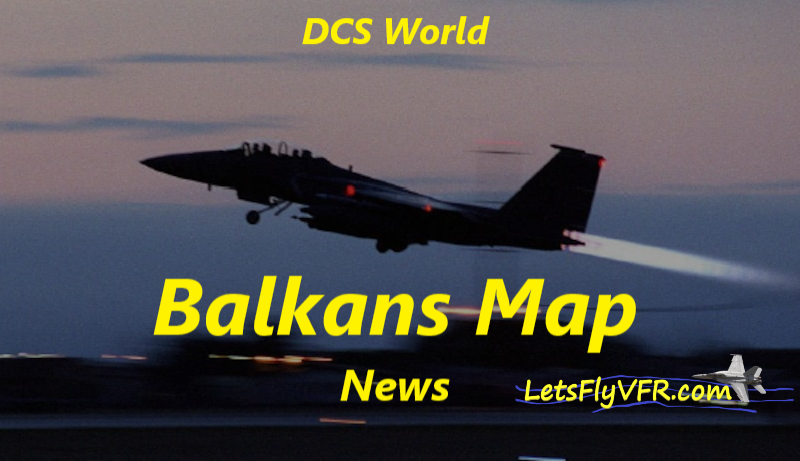




2 responses to “Cutting-Edge Military Flight Technology: From Analog Systems to 5th Generation Fighters.”